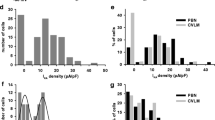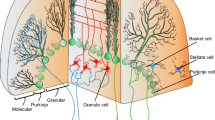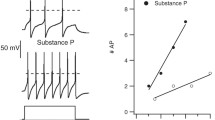Abstract
Non-adapting superior cervical ganglion (SCG) neurones with a clustering activity and sub-threshold membrane potential oscillations were occasionally recorded, suggesting the presence of a persistent sodium current (I NaP). The perforated-patch technique was used to establish its properties and physiological role. Voltage-clamp experiments demonstrated that all SCG cells have a TTX-sensitive I NaP activating at about −60 mV and with half-maximal activation at about −40 mV. The mean maximum I NaP amplitude was around −40 pA at −20 mV. Similar results were achieved when voltage steps or voltage ramps were used to construct the current–voltage relationships, and the general I NaP properties were comparable in mouse and rat SCG neurons. I NaP was inhibited by riluzole and valproate with an IC50 of 2.7 and 3.8 μM, respectively, while both drugs inhibited the transient sodium current (I NaT) with a corresponding IC50 of 34 and 150 μM. It is worth noting that 30 μM valproate inhibited the I NaP by 70% without affecting the I NaT. In current clamp, valproate (30 μM) hyperpolarised resting SCG membranes by about 2 mV and increased the injected current necessary to evoke an action potential by about 20 pA. Together, these results demonstrate for the first time that a persistent sodium current exists in the membrane of SCG sympathetic neurones which could allow them to oscillate in the sub-threshold range. This current also contributes to the resting membrane potential and increases cellular excitability, so that it is likely to play an important role in neuronal behaviour.






Similar content being viewed by others
References
Adams PR, Brown DA, Constanti A (1982) M-currents and other potassium currents in bullfrog sympathetic neurones. J Physiol 330:537–572
Adams PR, Brown DA, Constanti A (1982) Pharmacological inhibition of the M-current. J Physiol 332:223–262
Agrawal N, Hamam BN, Magistretti J, Alonso A, Ragsdale DS (2001) Persistent sodium channel activity mediates subthreshold membrane potential oscillations and low-threshold spikes in rat entorhinal cortex layer V neurons. Neuroscience 102:53–64
Alonso A, Klink R (1993) Differential electroresponsiveness of stellate and pyramidal-like cells of medial entorhinal cortex layer II. J Neurophysiol 70:128–143
Alonso A, Llinás RR (1989) Subthreshold Na+-dependent theta-like rhythmicity in stellate cells of entorhinal cortex layer II. Nature 342:175–177
Alzheimer C, Schwindt PC, Crill WE (1993) Modal gating of Na+ channels as a mechanism of persistent Na+ current in pyramidal neurons from rat and cat sensorimotor cortex. J Neurosci 13:660–673
Baker MD, Bostock H (1998) Inactivation of macroscopic late Na+ current and characteristics of unitary late Na+ currents in sensory neurons. J Neurophysiol 80:2538–2549
Belluzzi O, Sacchi O (1988) The interactions between potassium and sodium currents in generating action potentials in the rat sympathetic neurone. J Physiol 397:127–147
Brown DA, Constanti A (1980) Intracellular observations on the effects of muscarinic agonists on rat sympathetic neurones. Br J Pharmacol 70:593–608
Chao TI, Alzheimer C (1995) Effects of phenytoin on the persistent Na+ current of mammalian CNS neurones. Neuroreport 6:1778–1780
Crill WE (1996) Persistent sodium current in mammalian central neurons. Annu Rev Physiol 58:349–362
Cuevas J, Harper AA, Trequattrini C, Adams DJ (1997) Passive and active membrane properties of isolated rat intracardiac neurons: regulation by H- and M-currents. J Neurophysiol 78:1890–1902
Del Negro CA, Koshiya N, Butera RJ Jr, Smith JC (2002) Persistent sodium current, membrane properties and bursting behavior of pre-Bötzinger complex inspiratory neurons in vivo. J Neurophysiol 88:2242–2250
French CR, Sah P, Buckett KJ, Gage PW (1990) A voltage-dependent persistent sodium current in mammalian hippocampal neurons. J Gen Physiol 95:1139–1157
Galvan M, Sedlmeir C (1984) Outward currents in voltage-clamped rat sympathetic neurones. J Physiol 356:115–133
Gebhardt C, Breustedt JM, Noldner M, Chatterjee SS, Heinemann U (2001) The antiepileptic drug losigamone decreases the persistent Na+ current in rat hippocampal neurons. Brain Res 920:27–31
Gutfreund Y, Yarom Y, Segev I (1995) Subthreshold oscillations and resonant frequency in guinea-pig cortical neurons: physiology and modelling. J Physiol 483:621–640
Halliwell JV, Adams PR (1982) Voltage-clamp analysis of muscarinic excitation in hippocampal neurons. Brain Res 250:71–92
Jones SW (1989) On the resting potential of isolated frog sympathetic neurons. Neuron 3:153–161
Lamas JA (1998) A hyperpolarization-activated cation current (Ih) contributes to resting membrane potential in rat superior cervical sympathetic neurones. Pflugers Arch 436:429–435
Lamas JA, Selyanko AA, Brown DA (1997) Effects of a cognition-enhancer, linopirdine (DuP 996), on M-type potassium currents (IK(M)) and some other voltage- and ligand-gated membrane currents in rat sympathetic neurons. Eur J Neurosci 9:605–616
Lamas JA, Reboreda A, Codesido V (2002) Ionic basis of the resting membrane potential in cultured rat sympathetic neurons. Neuroreport 13:585–591
Magistretti J, Alonso A (1999) Biophysical properties and slow voltage-dependent inactivation of a sustained sodium current in entorhinal cortex layer-II principal neurons: a whole-cell and single-channel study. J Gen Physiol 114:491–509
Magistretti J, Mantegazza M, de Curtis M, Wanke E (1998) Modalities of distortion of physiological voltage signals by patch-clamp amplifiers: a modeling study. Biophys J 74:831–842
Martínez-Pinna J, Lamas JA, Gallego R (2002) Calcium current components in intact and dissociated adult mouse sympathetic neurons. Brain Res 951:227–236
Miles GB, Dai Y, Brownstone RM (2005) Mechanisms underlying the early phase of spike frequency adaptation in mouse spinal motoneurones. J Physiol (Lond) 566:519–532
Neher E (1992) Correction for liquid junction potentials in patch clamp experiments. Methods Enzymol 207:123–131
Nishi S, Koketsu K (1960) Electrical properties and activities of single sympathetic neurons in frogs. J Cell Comp Physiol 55:15–30
Pape HC, Driesang RB (1998) Ionic mechanisms of intrinsic oscillations in neurons of the basolateral amygdaloid complex. J Neurophysiol 79:217–226
Parri HR, Crunelli V (1998) Sodium current in rat and cat thalamocortical neurons: role of a non-inactivating component in tonic and burst firing. J Neurosci 18:854–867
Patlak JB, Ortiz M (1986) Two modes of gating during late Na+ channel currents in frog sartorius muscle. J Gen Physiol 87:305–326
Qu Y, Curtis R, Lawson D, Gilbride K, Ge P, DiStefano PS, Silos-Santiago I, Catterall WA, Scheuer T (2001) Differential modulation of sodium channel gating and persistent sodium currents by the b1, b2, and b3 subunits. Mol Cell Neurosci 18:570–580
Rae J, Cooper K, Gates P, Watsky M (1991) Low access resistance perforated patch recordings using amphotericin B. J Neurosci Methods 37:15–26
Reboreda A, Sánchez E, Romero M, Lamas JA (2003) Intrinsic spontaneous activity and subthreshold oscillations in neurones of the rat dorsal column nuclei in culture. J Physiol 551:191–205
Romero M, Reboreda A, Sánchez E, Lamas JA (2004) Newly developed blockers of the M-current do not reduce spike frequency adaptation in cultured mouse sympathetic neurons. Eur J Neurosci 19:2693–2702
Smith PA (1994) Amphibian sympathetic ganglia: an owner’s and operator’s manual. Prog Neurobiol 43:439–510
Stafstrom CE (2007) Persistent sodium current and its role in epilepsy. Epilepsy Curr 7:15–22
Stuart G, Sakmann B (1995) Amplification of EPSPs by axosomatic sodium channels in neocortical pyramidal neurons. Neuron 15:1065–1076
Taverna S, Mantegazza M, Franceschetti S, Avanzini G (1998) Valproate selectively reduces the persistent fraction of Na+ current in neocortical neurons. Epilepsy Res 32:304–308
Taverna S, Sancini G, Mantegazza M, Franceschetti S, Avanzini G (1999) Inhibition of transient and persistent Na+ current fractions by the new anticonvulsant topiramate. J Pharmacol Exp Ther 288:960–968
Urbani A, Belluzzi O (2000) Riluzole inhibits the persistent sodium current in mammalian CNS neurons. Eur J Neurosci 12:3567–3574
Wang HS, McKinnon D (1995) Potassium currents in rat prevertebral and paravertebral sympathetic neurones: control of firing properties. J Physiol 485:319–335
Zhong G, Masino MA, Harris-Warrick RM (2007) Persistent sodium currents participate in fictive locomotion generation in neonatal mouse spinal cord. J Neurosci 27:4507–4518
Acknowledgements
This work was supported by a grant to J. A. Lamas from the Spanish Ministry of Education and Science (MEC- BFU2005-03494). E. S., M. R. and A. R. were Ph.D. students under the Galician Predoctoral, Spanish FPU and Spanish FPI programmes, respectively. S. J. R. was supported by a grant from Xunta de Galicia, PGIDIT (06PXIC310095PN). We wish to thank A. Senra and V. Domínguez for their technical assistance.
Author information
Authors and Affiliations
Corresponding author
Additional information
J. A. L. and M. R. have contributed equally to this work.
Rights and permissions
About this article
Cite this article
Lamas, J.A., Romero, M., Reboreda, A. et al. A riluzole- and valproate-sensitive persistent sodium current contributes to the resting membrane potential and increases the excitability of sympathetic neurones. Pflugers Arch - Eur J Physiol 458, 589–599 (2009). https://doi.org/10.1007/s00424-009-0648-0
Received:
Revised:
Accepted:
Published:
Issue Date:
DOI: https://doi.org/10.1007/s00424-009-0648-0




